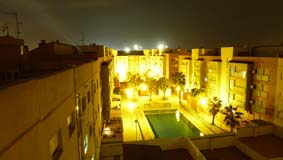
Professors from four departments of the University of Valencia have developed a report to inform about the light pollution generated by street lighting of white LEDs. The experts emphasized that this new type of lighting, which implies energy savings, incorporated at some valencian towns, increases light pollution and generate adverse effects on biodiversity, human health and astronomical observation.
For this reason, scientists and professors suggested that councils make lighting audits in order to reduce in 60% energy consumption, before carrying out any action to change current lighting of low pressure sodium. And, also that promote the approval of municipal regulations to protect the night sky.
The Office of the Vice-Principal for Sustanibility, Campus and Planification, which supports this initiative promoted by the Work Group on Light Pollution and the Chair for Science Dissemination UCC+i, puts at the disposal of Valencian institutions its experience and scientific knowledge in order to promote lighting systems more environmentally friendly. "Energy saving is a priority of the University of Valencia, as was stated in the project Campus Sostenible that affects all our areas of operation, thus the advances to reduce energy consumption should involve a global improvement in terms of sustainability", says the Vice-Principal Clara Martínez.
Light pollution is a serious problem that affects to the entire society. It is caused by excessive street lighting and the improper installation of lamps that shed part of lighting energy into the sky. White light, as the produced by white LEDs, it descomposes in various colors, which blue is the essential component. " For the dispersion theory of Rayleigh, short wavelenght light, such as the blue one, spreads more intensely in the atmosphere than light of other colors. Thus, occurs with the white light of Sun, which spreads blue color, giving this tonality to the sky", explains Enric Marco, researcher of the Department of Astronomy and Astrophysics. "White lights can be seen at longer distance than other warmer colours, such as red or yellow, so white LEDs contribute to increase the brightness of sky", says the Professor of the Department of Analytical Chemistry, Ángel Morales.
Detrimental to human health
"This pollution affects primarily to astronomers as they lose the opportunity to study the starry sky and they have to travel hundreds of kilometers to see the stars", highlights Marco. But it also harms human health and the flora and fauna adapted to darkness. Light, spefically white light, during night "reduces dramatically the production of melatonin, so prolonged night works, causes severe sleep and metabolism alterations that result in different types of diseases", asserts the Full University Professor of Anatomy and Human Embriology of the Faculty of Medicine, Francisco Martinez Soriano.
Melatonin is a hormone, the concentration of which varies according to day and night cycles, actually responds to changes in ambient lighting. It is produced in the pineal gland and participates in many cellular processes, endocrine and physiological, while it is essential for the regulation of the functional rhythm of metabolic and endocrine organs. Melatonin blood level is 10 and 20 times higher during night than during day; initiates its rise at evening and reaches its peak between 0:00 and 2:00, when it begins to decrease towards lower levels between 10-12 hours. "Melatonin not only responds to light intensity, but also to the different wavelenghts", recalls Martinez Soriano, who explains that during the last decade, "Numerous studies realized in humans and animals on the effects of different wavelenghts, have shown that the production of melatonin is altered, especially with the shorter, as in the case the ones emmitted by white LEDs". The levels of melatonin decrease in plasma, especially in the blue spectrum, depending on the time of exposure and intensity.
Effect on biodiversity
"Most living organisms use night to develop their activities, as darkness allow them to escape of predation, desiccation, ultraviolet radiation, and eventually to maintain a safer life", argues Professor Joaquin Baixeras, of the Cavanilles Institute of Biodiversity and Evolutionary Biology of the Science Park of the University of Valencia. Animals have developed sensorial organs that allow them to use tiny amounts of ambient light or complement the lacks with the development of sensorial alternatives such as smell or touch.
The case of insects is an illustrative example as they use navigation sytems based on stars of the firmament and the moon, but excessive artificial lighting influences this. "Insects are attracted to street lamps, for this reason they reduce their chances of feeding and reproduction, at the same time their physiology will suffer a considerable stress, and may find death for predation or injury by collision with street lamps, electrocution or blindness" adds Baixeras. Regarding to plants, like other fotodependents organisms they enter in a resting photosynthetic phase overnight. Consequently, excessive lighting can interfere with their development.
Enric Marco and Ángel Morales insist that the change of current low pressure sodium lights to LEDs, probably white, is basically for economic reasons. "LEDs are more expensive and is not tested that it last 25 years, in fact white LEDs promoted by the plans of the Diputació de Valencia have only few years of guarantee" It would be highly recommended that councils make more extensive studies on municipal lighting and that take into account not only the consumption of light, but if it a zone is over-illuminated in this case lamps could be removed. Also could be installed lighting regulators that lower the lights after midnight, turn off lights of sports centres and football fields when are not used and to avoid that shed light outside or requiere businesses that reduce lighting of shop windows during the night.
More information:
www.uv.es/cdciencia
Last update: 18 de december de 2012 09:05.
News release



















